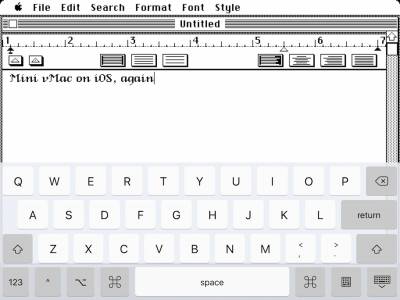

Update - Macintosh OS X 10.6.0 and later can no longer write to HFS disks or disk images. In this case,you should first uncompress it on a modern Macintosh(or with Stuffit Expander for Windows version 7as described below).On the other hand, old archives might not be understoodby modern software, so you sometimes need to try both ways.
Mini vmac retropie software#
It is common for more recently created archives tonot be usable by software that runs on aMacintosh Plus, even when the software in thearchive works on a Macintosh Plus.

Mini vmac retropie mac os#
Some versions of Mac OS for the Macintosh Plus, suchas System 7.5.5, can mount DOS format images,which opens some more possibilities for transferringfiles on non-Macintosh host operating systems.However, this seems to be especially prone tocorruption problems, so it is safest to use anew transfer disk image for each file transfer. You can get a new blank disk image from the" Blanks"archive. You should periodicallydelete your transfer disk image file and geta new one. It is better to use a separate disk image for transferringfiles, since using a disk image with both Mini vMac andother software, which usually seem to have slightly differentideas of the disk image format, tends to eventually lead tocorruption of the disk image. (HFVExplorerfor Windows is disappearing and HFSdisk image support has become flaky at times in OS X.) Update -The utilities ImportFl and ExportFl, which work inMini vMac 3.0.0 and later, provide an alternativeto the techniques described on this page formounting disk images in the host operating, whichhas become increasingly difficult. If you always use rechargeable battery, DC regulator can be skipped.Mini vMac uses 'disk image' files, that hold the informationof an emulated disk.For information about using disk images in Mini vMac,see the ' Floppy Drive'section of the Hardware Reference.This page is about transferring files from the host operatingsystem into and out of disk image files.The exact methods available depend on the operating system. I recommend using rechargeable battery for environment reason, 4 rechargeable AA battery provide 4.8 V power, it is a little bit lower than 5 V but Pi Zero can tolerate a little bit power shortage. So it require various size breadboard connected together:Ġ.3mm Nylon fishing line, it helps to fix pin header to Pi Zero without soldering Pin HeaderĢx40 18mm pin header Actually it only require 2x20 pins, but the pins is very easy broken while patching, so buy more for backup purpose ButtonĪny breadboard friendly button is OK, I an using:Īny breadboard friendly switch is OK DC-DC 5 V Regulator Moduleīattery Holder, power switch and DC regulator combined to provide 5 V power supply to Pi Zero. This project require connect Raspberry Pi Zero, 2.8 inch LCD, 12 controller buttons, power and audio components all together. Please check RPi compatible SD card list here: LCD ModuleĪ 165 mm x 112 mm plastic plate help to combine all component together Breadboard I know it is cheap but very hard to buy one, if you want the built-in WiFi feature, Zero W is easier to get and also it can enable net play for your game machine Micro SD card


 0 kommentar(er)
0 kommentar(er)
